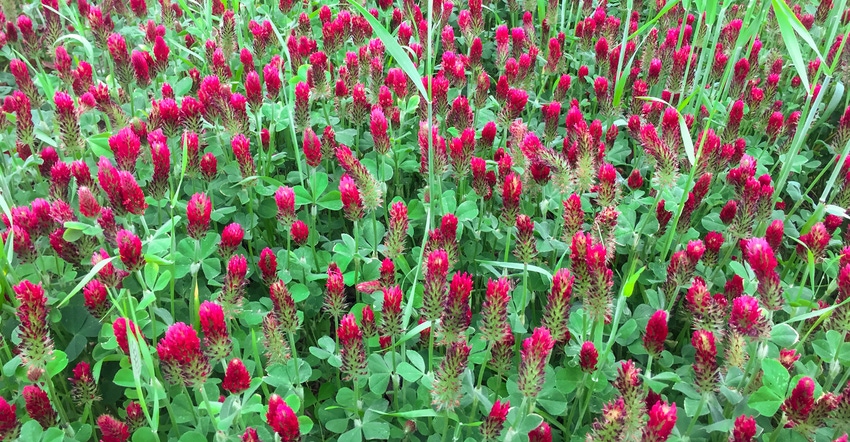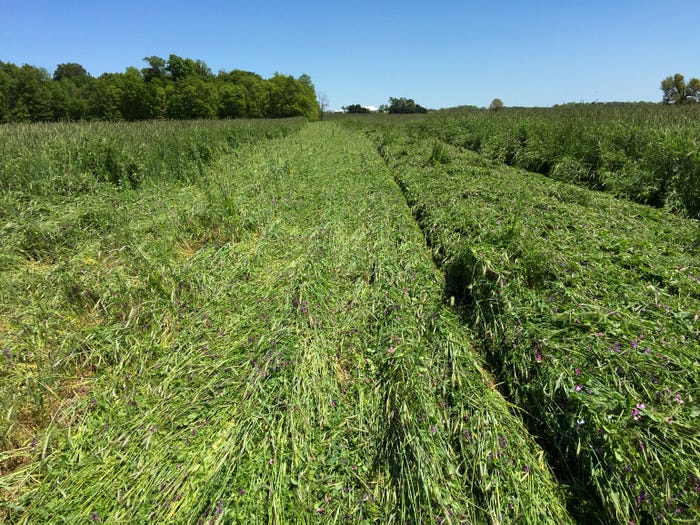
After planting and promoting cover crops for more than 40 years, Dave Brandt has heard plenty of reasons why some farmers aren’t planting them. But he’s also seen developments in equipment, seed selection and management that make it easier than ever for farmers to include them in their crop rotations.
Brandt, who farms near Carroll, Ohio, and runs Walnut Creek Seeds, ordinarily hosts a spring field day to demonstrate various cover crops and production practices. That had to be canceled this year due to COVID-19 concerns, but he still has plenty of advice to offer. Along with other Ohio cover crop experts, he addresses some of the concerns farmers have about cover crops.
 PLANTING GREEN: Dave Brandt has seen good results planting into green cover crops. This field has corn planted into a cover crop that has an estimated 20,000 pounds of biomass per acre.
PLANTING GREEN: Dave Brandt has seen good results planting into green cover crops. This field has corn planted into a cover crop that has an estimated 20,000 pounds of biomass per acre.

The comfort zone
Farmers using conventional production practices are often reluctant to leave their comfort zone to try cover crops, even if they recognize the benefits of cover crops for holding soil and improving water-holding capacity, Brandt says. He encourages them to take a longer-term view of their cost of production to shift toward a more cost-effective system that uses cover crops to retain nutrients. “If we don’t lose it, we don’t have to put it on,” he explains. Farmers will also see some cost savings in equipment operating costs, he adds. With no-till and cover crop systems, there may be fewer trips across each field, but they will also find that equipment pulls more easily as soil structure improves. “These are all little things we sometimes forget to talk about.”
Mike Willeke and Ryan Shanks also recognize the reluctance to change as a barrier for some farmers. They use cover crops on the land they farm together in northwest Ohio, and they also custom-plant cover crops and sell seed through their company, Buckeye Soil Solutions. “You have to be willing to change and accept that what you’ve been doing for 20 years, 30 years or 40 years may not be the best for your ground,” Shanks notes.
Mike’s son, Blake Willeke, an agronomy major graduating this spring from Ohio State University, says some of his college friends have been encouraging their dads and grandfathers to try cover crops. Last spring’s wet weather, with prevented corn and soybean planting, increased interest in cover crops, and he’s hoping to see farmers continue with them. However, farmers have to be patient to see the benefits in soil structure and nutrient management. “That’s not going to happen overnight,” Blake says.
Mentorship advantage
Jim Hoorman, a soil health consultant based in Hancock County, Ohio, also sees a reluctance from farmers to move away from traditional tillage practices. “I don’t think people like to get ridiculed if it doesn’t work out,” he explains. He recommends seeking out a mentor to help make the transition to crop rotations that include cover crops.
Experimenting with a few acres can help farmers build knowledge to make the shift with the entire farm, Hoorman adds — although he’s also seen farmers transition their entire farms at once. He doesn’t necessarily recommend that, since the learning curve is steep and a failure can be expensive, but making a whole-farm commitment seems to be motivating. “They have to make it work, and they find a way to make it work.”
Management mind shift
When farmers plan their crop production, they tend to take a step-by-step approach. With cover crops, however, they may not be able to follow such a structured plan, Shanks says. “You have to have a very fluid plan come spring.” For instance, he advises, instead of a straightforward one-two-three plan that might put tilling first, planting second and spraying third, farmers need to have plans A, B, C and D so they can adjust fieldwork, depending on the date they can get in the field and the field conditions.
Getting the cover crops planted can require some flexibility as well, according to Brandt. He suggests choosing shorter-season corn hybrids and soybean varieties to allow for earlier harvest, so there’s more time to get fall-planted cover crops established. But even if harvest is later, there are still options such as cereal rye that can be planted up until Thanksgiving, Shanks points out.
Farmers also have the option to get the cover crop planting done well ahead of harvest season, Brandt adds. He is experimenting with early interseeding equipment that puts two rows of cover crop seed between the rows of waist-high corn. He’s trying a combination of white Dutch clover with annual ryegrass. The cover crop seed sprouts, but it doesn’t grow much until the corn comes off. Then it’s ready to take off growing, he explains.
One caution with early interseeding is herbicide activity that prevents establishment, Brandt says. “We need to make sure to check our herbicide program over before we start interseeding.”
The equipment needed to interseed cover crops has become more widely available, and custom operators such as Buckeye Soil Solutions are also offering interseeding for farmers who don’t have their own equipment.
Buckeye Soil Solutions developed its own high-clearance interseeding equipment because owners Willeke and Shanks wanted more control than they could get with aerial seeding into standing crops. They began offering interseeding to other farmers to help pay for the equipment, and they expanded the cover crop business as demand grew, Willeke explains.
Keck writes from Raymond, Ohio.
About the Author(s)
You May Also Like




